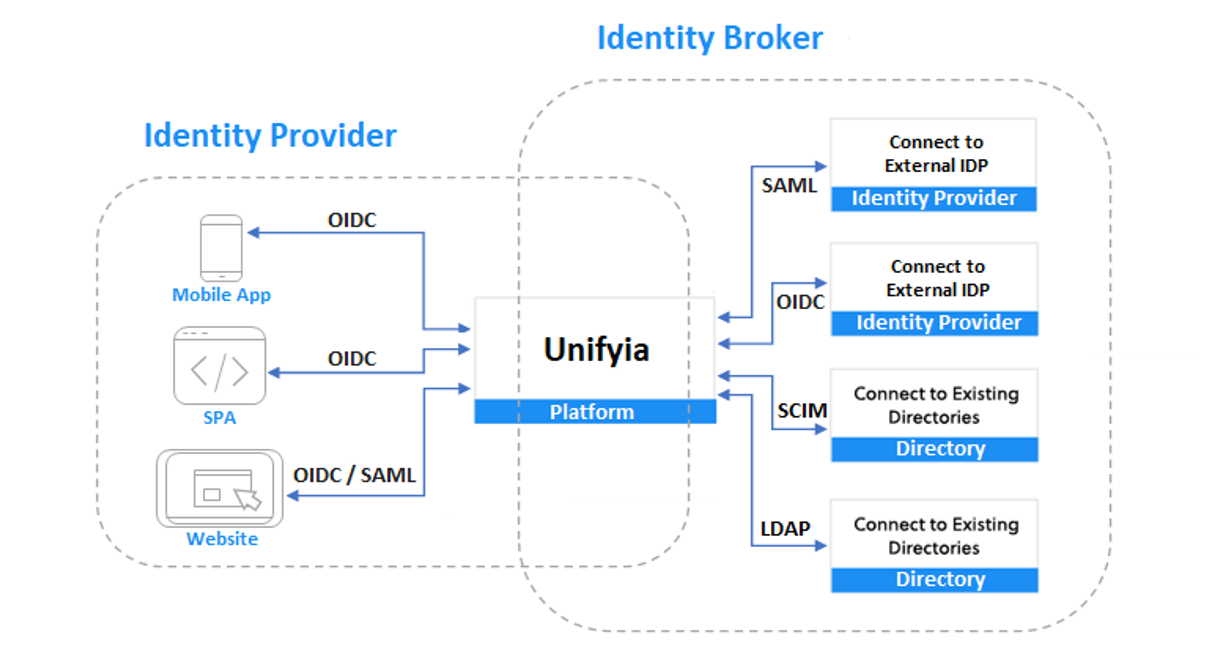Integrate Identity Providers
This page provides a concise overview of the following topics:
- What is an identity provider?
- Identity providers supported by the Unifyia platform
- Unifyia platform as an identity broker
- Rationale in integrating IdPs with the Unifyia platform
- Unifyia Platform Identity Brokerage Flow
Overview
When building an identity and access management system, it's crucial to offer the option of leveraging
existing authentication systems within organizations. This allows organizations intending to incorporate
modern identity management systems into their current architecture to encounter fewer obstacles in their
ongoing operations. This approach facilitates the integration of agile, contemporary identity and access
management solutions. Partnering with authentication providers brings numerous benefits in terms of
scalability, user-friendliness, and security.
Keeping the above premise in mind, the Unifyia platform has been developed to integrate multiple types of
data sources such as identity providers (IdPs), SCIM (System for Cross-domain Identity Management)
services, directories, enterprise connections for user and identity federation leveraging OAuth 2.0,
SAML (Security Assertion Markup Language) and OIDC (OpenID Connect) protocols. The platform has the
capability to function both as an identity provider and an identity broker leveraging both the SAML v2.0
and OpenID Connect v1.0 protocols to synchronize users and groups.
What is an Identity Provider?
An identity provider (IdP) is a centralized service for the management of user identities,
authentication, and authorization processes. This simplifies administration tasks and reduces the
complexity of managing user credentials across multiple systems as the authentication process is
centralized. It authenticates users and provides them with access to resources, applications, or
services based on their identity credentials.
Integrating IdP allows to enable SSO functionality, allowing users to access multiple applications or
services with a single set of login credentials thus reducing the need to remember and input multiple
passwords. It improves security as IdP integrations allow for multi-factor authentication and federated
identity management by using protocols such as SAML (Security Assertion Markup Language), OAuth, and
OIDC (OpenID Connect) to facilitate the secure exchange of authentication and authorization data.
With the Unifyia platform, you can effortlessly integrate IdPs to centrally manage users and their
identities by enabling user provisioning, synchronization, and SSO for federated identity management.
The platform supports identity brokering for IdPs based on both the OIDC v1.0 and SAML 2.0 protocols
provided they support the Authorization Code Flow defined in the specification to authenticate users and
authorize access.
Supported IdPs
The Unifyia platform supports the integration of the following IdPs:
Microsoft Entra
Microsoft Entra ID (formerly known as Microsoft Azure Active Directory or Azure AD) is a cloud-based
identity and access management (IAM) solution. It is a directory and identity management service that
operates in the cloud and offers authentication and authorization services to various Microsoft services
and other third-party services. You can integrate Entra ID as an IdP using the OIDC and SAML protocols
on the Unifyia platform and leverage the existing user credentials to log into the Unifyia platform.
Okta
Okta is an enterprise-grade, identity management service that helps IT to manage an employee's access to
applications or devices in an organization. You can integrate Okta as an IdP using the OIDC and SAML
protocols on the Unifyia platform and enable single sign-on for users to log into the platform using
Okta credentials.
Identity Brokerage with Unifyia Platform
Key Concepts
- Identity Provider (IdP): An IdP is a service that authenticates users and
provides identity information (such as user attributes) to other services. Examples include
Okta, Google, and Microsoft Azure AD.
- Service Provider (SP): An SP is a service or application that requires user
authentication to grant access. Examples include web applications, cloud services, and
enterprise systems.
- Identity Broker: An identity broker is an intermediary service that sits
between IdPs and SPs. It facilitates the authentication process by redirecting authentication
requests from SPs to the appropriate IdP and then returning the authentication response to the
SP.

The Unifyia platform acts as an intermediary service, also known as the identity broker, that acts as a
bridge between different identity providers (IdPs) and service providers (SPs). This enables users to
authenticate with a single identity provider and gain access to multiple services or applications
without needing separate credentials for each one.
Why should you integrate IdPs with the Unifyia platform?
Integrating Identity Providers (IdPs) allows organizations to enhance security, improve user experience
with single sign-on, centralize identity management, ensure compliance, and boost operational
efficiency. By integrating multiple IdPs, users can authenticate with their preferred or existing
identity providers once and gain access to multiple Service Providers (SPs). This eliminates the need
for users to remember multiple sets of credentials. Service Providers only need to integrate with the
identity broker (such as the Unifyia platform), rather than individually integrating with multiple IdPs.
Leveraging identity broker services provides a centralized point for managing authentication policies,
user mappings, and transformations. This enables users to authenticate once with their IdP and access
multiple SPs, further reducing the need to remember multiple sets of credentials.
Unifyia Platform Identity Brokerage Flow
Once an IdP is integrated with the Unifyia Platform, you will notice a button with the name/logo of the
IdP on the platform’s sign-in page.
- User Request: A user attempts to access the Unifyia Platform (SP) that requires
authentication using the existing credentials of the integrated IdP. The user selects their IdP and
is redirected to that IdP’s login page.
- Authentication: The user authenticates with the chosen IdP using their credentials.
- Response Handling: Upon successful authentication, the IdP sends an authentication
response (containing identity information) back to the Unifyia platform (identity broker).
- Mapping and Transformation: The Unifyia platform may map and transform the received
identity information to fit the requirements of the SP.
- Access Granted: The identity broker sends the transformed authentication response
to the SP, granting the user access to the service.